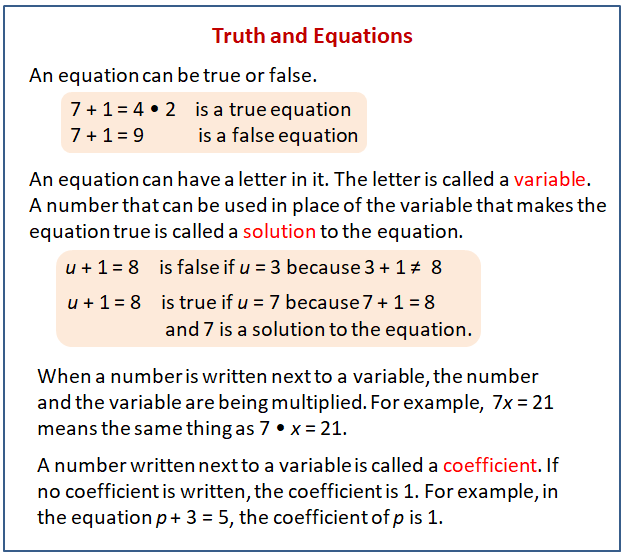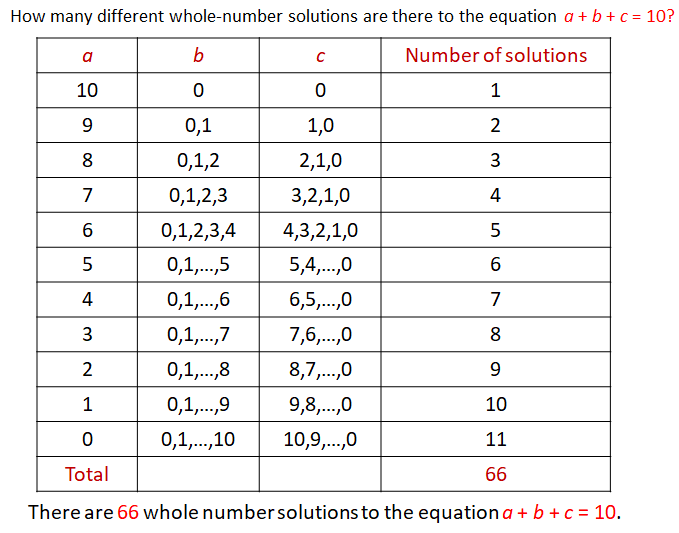Illustrative Mathematics Unit 6.6, Lesson 2: Truth and Equations
Learning Targets:
- I can match equations to real life situations they could represent.
- I can replace a variable in an equation with a number that makes the equation true, and know that this number is called a solution to the equation.
Related Pages
Illustrative Math
Grade 6
Lesson 2: Truth and Equations
Let’s use equations to represent stories and see what it means to solve equations.
Illustrative Math Unit 6.6, Lesson 2 (printable worksheets)
Lesson 2 Summary
The following diagram shows what is a true and false equation, variable, solution and coefficient.

Lesson 2.1 Three Letters
The equation a + b = c could be true or false.
a. If a is 3, b is 4, and c is 5, is the equation true or false?
b. Find new values of a, b, and c that make the equation true.
c. Find new values of a, b, and c that make the equation false.
2. The equation x · y = z could be true or false.
a. If x is 3, y is 4, and z is 12, is the equation true or false?
b. Find new values of x, y, and z that make the equation true.
c. Find new values of x, y, and z that make the equation false.
Scroll down the page for the solutions to the “Are you ready for more?” section.
Lesson 2.2 Storytime
Here are three situations and six equations. Which equation best represents each situation? If you get stuck, draw a diagram.
- After Elena ran 5 miles on Friday, she had run a total of 20 miles for the week. She ran x miles before Friday.
- Andre’s school has 20 clubs, which is five times as many as his cousin’s school. His cousin’s school has x clubs.
- Jada volunteers at the animal shelter. She divided 5 cups of cat food equally to feed 20 cats. Each cat received x cups of food.
x + 5 = 20
x + 20 = 5
x = 20 + 5
5 · 20 = x
5x = 20
20x = 5
Lesson 2.3 Draw Diagrams for Equations
Here are some equations that contain a variable and a list of values. Think about what each equation means and find a solution in the list of values. If you get stuck, draw a diagram. Be prepared to explain why your solution is correct.
Are you ready for more?
One solution to the equation a + b + c = 10 is a = 2, b = 5, c = 3.
How many different whole-number solutions are there to the equation a + b + c = 10? Explain or show your reasoning.
Glossary Terms
coefficient
A coefficient is a number that is multiplied by a variable.
For example, in the expression 3x + 5, the coefficient of x is 3. In the expression y + 5, the coefficient of y is 1, because y = 1 · y.
solution to an equation
A solution to an equation is a number that can be used in place of the variable to make the equation true.
For example, 7 is the solution to the equation m + 1 = 8, because it is true that 7 + 1 = 8. The solution to m + 1 = 8 is not 9, because 9 + 1 ≠ 8.
variable
A variable is a letter that represents a number. You can choose different numbers for the value of the variable.
For example, in the expression 10 - x, the variable is x. If the value of x is 3, then 10 - x = 7, because 10 - 3 = 7. If the value of x is 6, then 10 - x = 4, because 10 - 6 = 4.
Lesson 2 Practice Problems
- Select all the true equations.
A. 5 + 0 = 0
B. 15 · 0 = 0
C. 1.4 + 2.7 = 4.1
D. 2/3 · 5/9 = 7/12
E. 4 2/3 = 5 - 1/3 - Mai’s water bottle had 24 ounces in it. After she drank x ounces of water, there were 10 ounces left. Select all the equations that represent this situation.
A. 24 ÷ 10 = x
B. 24 + 10 = x
C. 24 - 10 = x
D. x + 10 = 24
E. 10x = 24 - Priya has 5 pencils, each x inches in length. When she lines up the pencils end to end, they measure 34.5 inches. Select all the equations that represent this situation.
A. 5 + x = 34.5
B. 5x = 34.5
C. 34.5 ÷ 5 = x
D. 34.5 - 5 = x
E. x = (34.5) · 5 - Match each equation with a solution from the list of values.
- The daily recommended allowance of vitamin C for a sixth grader is 45 mg. 1 orange has about 75% of the recommended daily allowance of vitamin C. How many milligrams are in 1 orange? If you get stuck, consider using the double number line.
- There are 90 kids in the band. 20% of the kids own their own instruments, and the rest rent them.
a. How many kids own their own instruments?
b. How many kids rent instruments?
c. What percentage of kids rent their instruments?
The Open Up Resources math curriculum is free to download from the Open Up Resources website and is also available from Illustrative Mathematics.
Try out our new and fun Fraction Concoction Game.
Add and subtract fractions to make exciting fraction concoctions following a recipe. There are four levels of difficulty: Easy, medium, hard and insane. Practice the basics of fraction addition and subtraction or challenge yourself with the insane level.

We welcome your feedback, comments and questions about this site or page. Please submit your feedback or enquiries via our Feedback page.
